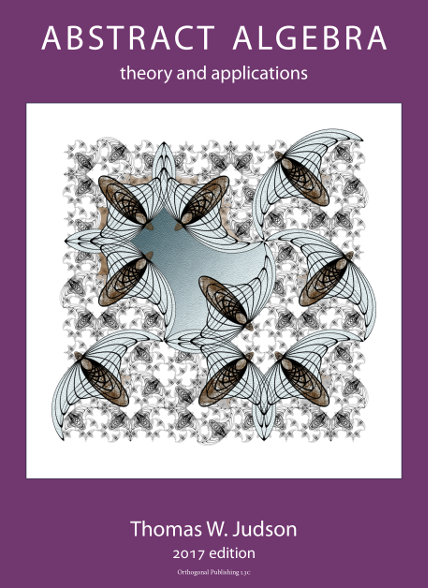1
Find all the subgroups of \({\mathbb Z}_3 \times {\mathbb Z}_3\text{.}\) Use this information to show that \({\mathbb Z}_3 \times {\mathbb Z}_3\) is not the same group as \({\mathbb Z}_9\text{.}\) (See Example 3.13 for a short description of the product of groups.)
2
Find all the subgroups of the symmetry group of an equilateral triangle.
3
Compute the subgroups of the symmetry group of a square.
4
Let \(H = \{2^k : k \in {\mathbb Z} \}\text{.}\) Show that \(H\) is a subgroup of \({\mathbb Q}^*\text{.}\)
5
Let \(n = 0, 1, 2, \ldots\) and \(n {\mathbb Z} = \{ nk : k \in {\mathbb Z} \}\text{.}\) Prove that \(n {\mathbb Z}\) is a subgroup of \({\mathbb Z}\text{.}\) Show that these subgroups are the only subgroups of \(\mathbb{Z}\text{.}\)
6
Let \({\mathbb T} = \{ z \in {\mathbb C}^* : |z| =1 \}\text{.}\) Prove that \({\mathbb T}\) is a subgroup of \({\mathbb C}^*\text{.}\)
7
Let \(G\) consist of the \(2 \times 2\) matrices of the form
\begin{equation*}
\begin{pmatrix}
\cos \theta & -\sin \theta \\
\sin \theta & \cos \theta
\end{pmatrix},
\end{equation*}
where \(\theta \in {\mathbb R}\text{.}\) Prove that \(G\) is a subgroup of \(SL_2({\mathbb R})\text{.}\)
8
Prove that
\begin{equation*}
G = \{ a + b \sqrt{2} : a, b \in {\mathbb Q} \text{ and } a \text{ and } b \text{ are not both zero} \}
\end{equation*}
is a subgroup of \({\mathbb R}^{\ast}\) under the group operation of multiplication.
9
Let \(G\) be the group of \(2 \times 2\) matrices under addition and
\begin{equation*}
H =
\left\{
\begin{pmatrix}
a & b \\
c & d
\end{pmatrix} :
a + d = 0
\right\}.
\end{equation*}
Prove that \(H\) is a subgroup of \(G\text{.}\)
10
Prove or disprove: \(SL_2( {\mathbb Z} )\text{,}\) the set of \(2 \times 2\) matrices with integer entries and determinant one, is a subgroup of \(SL_2( {\mathbb R} )\text{.}\)
11
List the subgroups of the quaternion group, \(Q_8\text{.}\)
12
Prove that the intersection of two subgroups of a group \(G\) is also a subgroup of \(G\text{.}\)
13
Prove or disprove: If \(H\) and \(K\) are subgroups of a group \(G\text{,}\) then \(H \cup K\) is a subgroup of \(G\text{.}\)
14
Prove or disprove: If \(H\) and \(K\) are subgroups of a group \(G\text{,}\) then \(H K = \{hk : h \in H \text{ and } k \in K \}\) is a subgroup of \(G\text{.}\) What if \(G\) is abelian?
15
Let \(G\) be a group and \(g \in G\text{.}\) Show that
\begin{equation*}
Z(G) = \{ x \in G : gx = xg \text{ for all } g \in G \}
\end{equation*}
is a subgroup of \(G\text{.}\) This subgroup is called the center of \(G\text{.}\)
16
Let \(a\) and \(b\) be elements of a group \(G\text{.}\) If \(a^4 b = ba\) and \(a^3 = e\text{,}\) prove that \(ab = ba\text{.}\)
17
Give an example of an infinite group in which every nontrivial subgroup is infinite.
Resuming from the Sage exercises in Section 2.5, create the groups CyclicPermutationGroup(8) and DihedralGroup(4) and name these groups C and D, respectively.
18Sage Exercise 1
For C locate the one subgroup of order \(4\text{.}\) The group D has three subgroups of order \(4\text{.}\) Select one of the three subgroups of D that has a different structure than the subgroup you obtained from C.
The .subgroups() method will give you a list of all of the subgroups to help you get started. A Cayley table will help you tell the difference between the two subgroups. What properties of these tables did you use to determine the difference in the structure of the subgroups?
19Sage Exercise 2
The .subgroup(elt_list) method of a group will create the smallest subgroup containing the specified elements of the group, when given the elements as a list elt_list. Use this command to discover the shortest list of elements necessary to recreate the subgroups you found in the previous exercise. The equality comparison, ==, can be used to test if two subgroups are equal.
